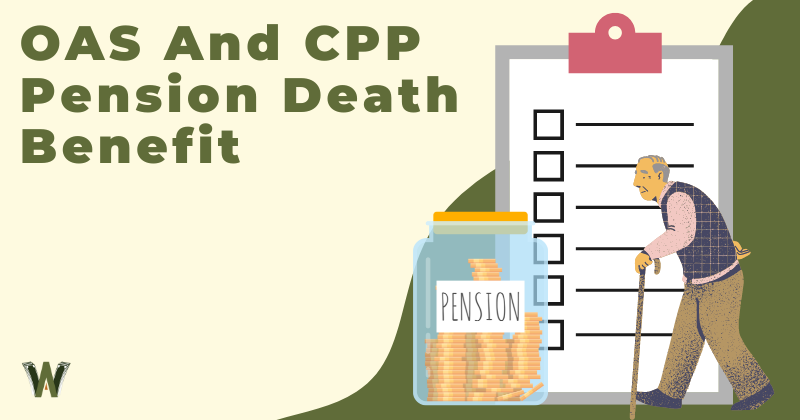In the event that your spouse or common-law partner passes away in retirement, you may be curious to know what government benefits you can use to soften the financial blow during this difficult time.
If your spouse or common-law partner has deceased in retirement, you may be eligible for several important government benefits.
Although each has specific criteria to qualify, these benefits include a death benefit payment of $2,500 as well as monthly payments through the CPP survivor’s pension and the Allowance for the Survivor.
I will cover the OAS and CPP pension death benefits below and dive into the specifics of qualifying for each.
The Death of a Spouse or Common-Law Partner in Retirement
The passing of your significant other during retirement can put extreme financial pressure on you, especially if your retirement savings are modest. As of 2020, the life expectancy for women in Canada was approximately 83.9 years, while men only had a life expectancy of 79.7 years.
When living with a partner in retirement, a portion of your retirement costs can be shared, including the cost of housing. The passing of a spouse can also lead to additional costs, such as elderly care.
While it is extremely important to save up throughout your working years for a comfortable retirement, you will also want to take advantage of government benefits that are available to you.
The CPP Death Benefit
The Canada Pension Plan death benefit is a lump-sum payment that is available to a CPP contributor’s estate (or eligible individuals) upon their death. There are qualifications that must be met in order to be eligible for the CPP death benefit, which is currently a single payment of $2,500.
In order to receive the CPP death benefit, the contributor who has passed away must have met one of the two criteria:
- Contributed to the Canada Pension Plan for at least ten calendar years
- Contributed to the CPP for one-third of the calendar years during their contributory period for base CPP (but for at least three calendar years)
If the deceased contributor has lived outside of Canada, they may still qualify for the CPP death benefit.
The estate’s executor should apply to receive the CPP death benefit within 60 days of the contributor’s death. In the event that there is no estate, the CPP death benefit can be paid out to the following:
- Whoever is paying for the funeral expenses of the deceased
- The surviving spouse or common-law partner of the deceased
- Next-of-kin
The CPP death benefit is not the only government aid that you can receive in the event that your spouse or common-law partner passes away.
The Allowance for the Survivor
The Allowance for the Survivor benefit is a monthly payment from the government that can be received if you meet specific criteria. As of early 2023, the maximum monthly payment amount of $1,556.51, making it a fairly sizable retirement income stream.
Qualifying to receive the Allowance for the Survivor is fairly difficult – you must meet four main criteria:
- You must be between the ages of 60 and 64
- You must live in Canada
- You have not remarried or become a common-law partner to someone else since your spouse or common-law partner has passed away.
- Your annual income is below the maximum annual income threshold for this benefit.
As of 2023, your annual income must be below $28,080 per year in order to receive the Allowance for the Survivor.
Although the qualifications for this benefit are stringent, there is one more government benefit that is much easier to obtain.
The Survivor’s Pension

The survivor’s pension is offered by the Canada Pension Plan to the common-law partner or spouse of a deceased CPP contributor.
Qualifying for this benefit simply requires that you were married or in a common-law partnership with the deceased CPP contributor. There are no additional qualifications to be met.
In the event that you have had more than one deceased spouse or common-law partner (you have been widowed more than once), you will only receive one survivor’s pension (the largest one).
Your survivor’s pension will continue to be paid even if you decide to remarry.
How large a survivor’s pension is will depend on your age as well as for how long and how much the deceased contributor has paid into CPP.
If you are 65 years of age or older, you will receive 60% of the deceased contributor’s pension (if you are not receiving other CPP benefits).
If you are younger than 65 years of age, you will receive 37.5% of the deceased contributor’s pension plus a flat amount (if you are not receiving other CPP benefits).
The survivor’s pension is combined with your other CPP payments into one payment. If you are receiving other payments from CPP, the survivor’s pension will be lower than the figures above.
In terms of what amounts to expect, the calculation for the survivor’s pension assumes that the deceased was 65 at the time of death, on top of a few other calculations.
Frequently Asked Questions
OAS Survivor Benefits?
The Allowance for the Survivor, covered above, is the survivor benefit that is related to OAS and not linked to the Canada Pension Plan. Both the survivor’s pension and the CPP death benefit are linked to the Canada Pension Plan.
Supplementary Death Benefit in Canada?
The supplementary death benefit is a benefit that public sector employees can choose to take advantage of. It is similar to a decreasing term life insurance policy.
This benefit is a one-time payment of twice your annual salary that is paid to a designated beneficiary or to the estate. The monthly cost of this benefit (or insurance) is $0.15 per month for every $1,000 of coverage while still employed in the public sector.
Your coverage is rounded to the nearest thousand dollars. As a hypothetical example:
You are earning $61,300 per year as a public sector employee. Your supplementary death benefit would be $61,300 x 2 = $122,600. Rounded up to the nearest $1,000, the supplementary death benefit is $123,000. Your monthly cost would be $18.45 per month (15 cents for each $1,000 of coverage).
There are a lot more specifics to be aware of if you are looking to learn more about the supplementary death benefit in Canada.
How much is the Allowance for the Survivor?
Your previous year’s income will determine the amount of the allowance for the survivor. As of early 2023, this amount is a maximum of $1,556.51 per month.
The amount that is paid out (as well as the maximum) is constantly being compared to the cost of living increases in Canada’s Consumer Price Index (CPI). If Canada’s CPI increases, this payment can increase. If Canada’s CPI decreases, the income will not decrease.
Conclusion

If your spouse or common-law partner has recently passed away, there are a number of government benefits that you may qualify for in order to help with paying for retirement expenses.
The Canada Pension Plan death benefit, CPP’s survivor pension, and the Allowance for the Survivor are some of the main sources of assistance that you may be able to count on.
You will want to have as much control over your income streams in retirement in order to qualify for certain benefits as well as positively-impact others.
If you are looking for additional retirement tips and strategies, be sure to read my guide on retirement planning in Canada.




